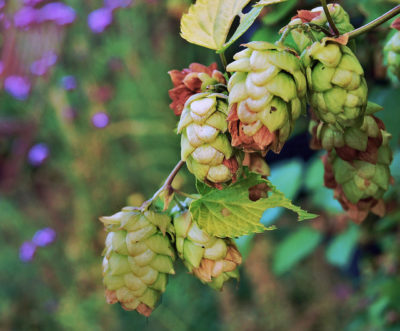
Hop flowers - Photo by Duncan Harris
Hop is a dioecious plant, which means that male and female flowers are found on separate individual plants. In hop cultivation only the female plants are used.
The female flowers of hop are used in the production of beer. They give the bitterness and flavor, and also act as preservative.
Hop is a herbaceous climbing vine. It is a perennial plant. New shoots develop in spring and the plant dies back to a rhizome in autumn.
Names
Scientific
Humulus lupulus
English
Common hop
Hop
Dutch
Hop
Spanish
Lúpulo
French
Houblon
Vigne du Nord
German
Echter Hopfen
Italian
Luppolo
Taxonomy
Order
Rosales
Family
Cannabaceae
Genus
Humulus
Species
Humulus lupulus (Hop)
Basic information and facts
Origin:
Distribution:
Countries that produce a lot of hop include Germany, USA, China, Czech Republic, Poland, Slovenia, North Korea, United Kingdom, Albania and Australia.
Annual, biennial, or perennial:
Hop is a perennial plant. In autumn the plant dies back to a rhizome which can survive the cold winter period. It then develops new shoots in spring.
Plant:
Hop is a herbaceous climbing vine. In a hopfield the plants are usually supported by strings. The hop plant is dioecious, which means that there are separate plants with male or female flowers.
Flowers:
The hop plant is grown for its female flowers. The light green flower cones (called hops) are fragrant and are used in beer brewing for their bitterness and flavor. They also have preservative qualities.
Climate and weather:
Hop grows best in moist temperate climates.
Pollination:
In hop production pollination is not desired. In a hopfield only female plants will be kept.
Height:
The hop vines usually grow to about 5 to 6 meter tall.
Spacing:
Hops are grown at spacing of 2 x 2 meters or in rows with 1 meter space within rows and 3 meters between rows.
Propagation:
Female plants are propagated vegetatively.
Hop can also be grown from seed. In that case the emerging male plants will be removed and only female plants are kept.
Insect pests:
Common pests of hop include the Hop leaf aphid (Phorodon humuli) and the Red spider mite (Tetranychus urticae).
Diseases:
Hop diseases include Downy mildew and Powdery mildew.
Harvesting:
Hop flowers can be hand picked but nowadays in large scale production hop-harvesting machines are used.
Uses:
The dried female flowers are used in beer brewing. The dried flowers are sometimes ground and then pressed to make hop pellets.
Hops are also used in herbal medicines to treat anxiety, restlessness and insomnia.
Proverbs and Quotes
- Kent, sir – everybody knows Kent – apples, cherries, hops, and women. (Charles Dickens)
- In wine there is wisdom. In beer there is strength. In water there is bacteria.
- We are getting by on our hips and hops. (a common British wartime expression)
Did you know that?
- A pillow filled with hops is a popular folk remedy for sleeplessness.
- The “Reinheitsgebot” or “German Beer Purity Law” was a law that dictated that in the production of beer only water, barley and hops should be used.
Crop categories
Cool temperate crops
Herbs
Mediterranean crops
Minor crops
Temperate crops
Pictures

Hop flowers - Photo by David Blaikie

Hop pellets - Photo by Epic Beer

Hop - Photo by Drew from Zhrodague

Hop - Photo by Bernt Rostad
